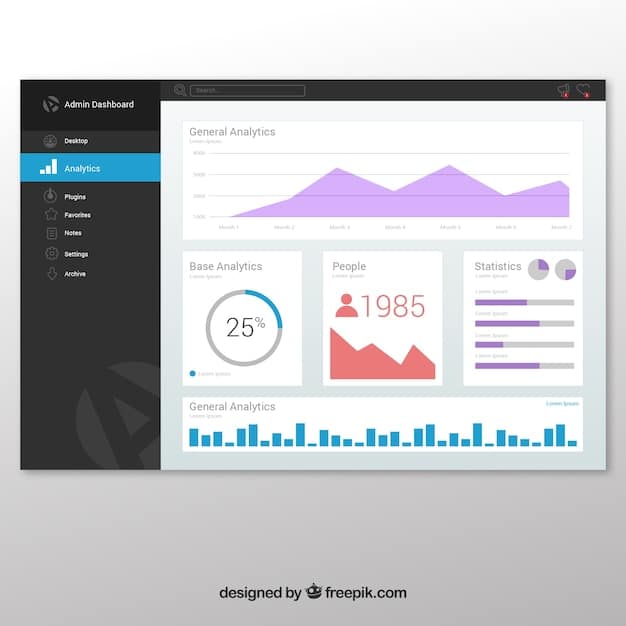The Future of Digital Advertising: Privacy-Focused Targeting Shifts

The Future of Digital Advertising: How Will the Shift to Privacy-Focused Browsers Impact Ad Targeting? This transition necessitates innovative strategies like contextual advertising, first-party data utilization, and enhanced data analytics to maintain effective ad campaigns while respecting user privacy.
The digital advertising landscape is undergoing a seismic shift. The increasing emphasis on user privacy, driven by regulations like GDPR and the deprecation of third-party cookies by browsers such as Chrome and Safari, is reshaping how ads are targeted and delivered. Understanding the future of digital advertising: how will the shift to privacy-focused browsers impact ad targeting? is crucial for businesses and marketers to adapt and thrive in this evolving environment.
Understanding the Privacy-Focused Shift
The internet is becoming increasingly concerned with privacy. Recent years have seen a surge in privacy regulations and a growing user awareness of how their data is collected and used. This heightened awareness has led to significant changes in browser policies and the overall digital advertising ecosystem.
This shift towards privacy-focused browsing is not a fleeting trend but a fundamental change in how users interact with the internet and how businesses must engage with them. Understanding the drivers behind this shift is essential for navigating the future of digital advertising.
The Rise of Privacy Regulations
Regulations such as the General Data Protection Regulation (GDPR) in Europe and the California Consumer Privacy Act (CCPA) in the United States have empowered users with greater control over their personal data. These regulations require businesses to obtain explicit consent for data collection and provide users with the right to access, rectify, and erase their data.
- GDPR Compliance for Global Reach: Even if a business isn’t based in Europe, if it collects data from European citizens, it must comply with GDPR.
- CCPA and State-Level Privacy Laws: The CCPA is just one example; many other states are considering or have already passed their own privacy laws.
- Global Impact on Data Handling: These regulations have set a precedent, influencing data protection laws and practices worldwide.
In conclusion, the increase in privacy regulations highlights the importance of prioritizing consumer consent and ethical data practices in digital advertising moving forward.

The Impact on Ad Targeting Techniques
Traditional ad targeting techniques heavily relied on third-party cookies to track user behavior across websites. The deprecation of these cookies is forcing advertisers to rethink their strategies and explore alternative methods.
This transition requires a deep understanding of how ad targeting is affected and what new approaches are necessary to maintain effective campaigns while respecting user privacy.
Challenges with Cookie Deprecation
The removal of third-party cookies presents significant challenges for advertisers. Without this cross-site tracking capability, it becomes harder to understand user interests and deliver relevant ads.
Cookie deprecation isn’t just an inconvenience; it’s a fundamental disruption that necessitates a complete rethink of ad targeting strategies.
- Reduced Accuracy in Targeting: Advertisers lose the ability to precisely target users based on their browsing history.
- Increased Reliance on Contextual Data: Advertisements become more dependent on the immediate context of the websites they appear on.
- Need for First-Party Data Strategies: Businesses must build and leverage their own data from direct customer interactions.
Successfully navigating the impact of cookie deprecation requires a blend of innovative technologies, ethical data practices, and a commitment to delivering value to consumers alongside relevant advertising.
Emerging Strategies for Privacy-Safe Advertising
As traditional methods become less viable, new privacy-safe advertising strategies are emerging. These approaches prioritize user consent, data minimization, and contextual relevance.
These strategies represent a future where advertising is not only effective but also respectful of user privacy, creating a more sustainable and trustworthy advertising ecosystem.

Contextual Advertising
Contextual advertising involves placing ads based on the content of the webpage being viewed. Rather than tracking user behavior, the ad is relevant to the topic being discussed on the page.
- Relevance and Engagement: Ads align with the content users are actively consuming, increasing the likelihood of engagement.
- Reduced Privacy Concerns: No user data is tracked, as targeting is based solely on the webpage’s context.
- Brand Safety: Ensuring ads appear alongside appropriate and brand-safe content is crucial.
In summary, contextual advertising offers a privacy-respecting alternative to traditional methods by focusing on the immediate relevance of content.
Leveraging First-Party Data Effectively
First-party data, which is data collected directly from customers, is becoming increasingly valuable. Businesses can use this data to personalize ads and create more relevant experiences without relying on third-party cookies.
Building strong direct relationships with customers is essential for gathering and using valuable first-party data.
Building Customer Relationships
Creating direct relationships with customers allows businesses to collect valuable first-party data. This can be achieved through loyalty programs, email marketing, and personalized website experiences.
Direct customer relationships aren’t just about collecting data; they’re about building trust and providing value in a transparent and mutually beneficial way.
Data Collection Transparency: Clearly communicate how data is being collected and used.
Incentivizing Data Sharing: Offer rewards or exclusive content in exchange for customer data.
Thus, nurturing direct connections with clients provides invaluable insights used to inform strategy and enhance targeting.
The Role of Data Analytics and AI
Data analytics and artificial intelligence play a crucial role in making the most of privacy-safe advertising strategies. These technologies can help businesses analyze first-party data, identify patterns, and optimize ad campaigns.
Effective data analytics and AI are key to unlocking the full potential of privacy-safe advertising strategies by enabling businesses to understand, predict, and respond to customer needs in a privacy-conscious manner.
Enhancing Ad Campaign Optimization
AI and machine learning algorithms can analyze vast amounts of data to optimize ad campaigns. This can involve identifying the most effective ad creatives, targeting the right audience segments, and adjusting bids in real-time.
- Predictive Analytics: Use AI to forecast customer behavior and optimize ad spend accordingly.
- Personalized Recommendations: Offer tailored products and services based on individual customer preferences.
- Automated Bidding Strategies: Implement AI-driven bidding strategies to maximize ROI.
By using AI, businesses can significantly improve the efficiency and effectiveness of their ad campaigns while respecting the privacy of their customers.
Preparing for the Future of Digital Advertising
The future of digital advertising requires a proactive approach. Businesses must adapt their strategies, invest in new technologies, and prioritize user privacy to thrive in this evolving landscape.
Ultimately, preparing for this involves embracing a privacy-first mindset and adopting strategies that respect user autonomy while still achieving business goals.
Embracing Privacy-Enhancing Technologies
Privacy-enhancing technologies (PETs) offer innovative ways to protect user data while still enabling effective ad targeting. These technologies include differential privacy, homomorphic encryption, and secure multi-party computation.
Investing upfront in these technologies is vital to remaining competitive in the everchanging landscape of digital marketing.
In the near-term, focusing on privacy-enhancing technologies is vital for ensuring compliance with regulations and sustaining user trust.
| Key Point | Brief Description |
|---|---|
| 🔒 Privacy-Focused Browsers | Browsers are increasingly prioritizing privacy, impacting ad targeting. |
| 🎯 Ad Targeting Techniques | Cookie deprecation challenges traditional ad targeting methods. |
| 📈 First-Party Data | Leveraging data collected directly from customers is crucial. |
| 🤖 AI and Analytics | AI and data analytics are essential for optimizing privacy-safe ads. |
Frequently Asked Questions (FAQ)
▼
Privacy-focused browsers are web browsers that prioritize user privacy by blocking trackers, cookies, and other data collection methods by default, enhancing user control over their personal information online.
▼
Cookie deprecation is occurring due to increasing user awareness and regulatory pressure to protect online privacy, leading browsers to phase out third-party cookies that track user behavior across websites.
▼
First-party data is information that companies collect directly from their customers, offering valuable insights for personalized marketing and advertising without relying on external tracking mechanisms.
▼
Contextual advertising delivers ads based on the content of a webpage, rather than user behavior, ensuring ad relevance while respecting user privacy by focusing on the immediate context.
▼
Privacy-enhancing technologies (PETs) are tools and techniques designed to protect user data while enabling effective ad targeting, ensuring compliance with privacy regulations and fostering a sustainable advertising ecosystem.
Conclusion
The shift towards privacy-focused browsers is revolutionizing digital advertising. By embracing emerging strategies like contextual advertising, leveraging first-party data, and investing in data analytics and privacy-enhancing technologies, businesses can navigate this evolving landscape and build a future where advertising is both effective and respectful of user privacy.





